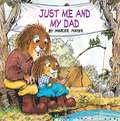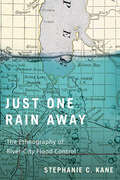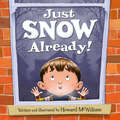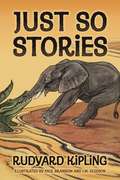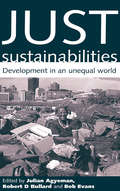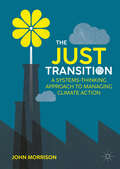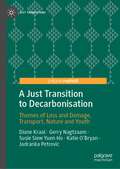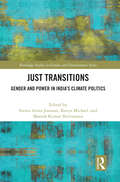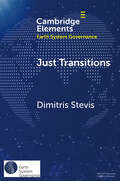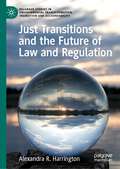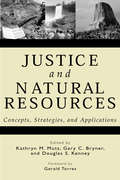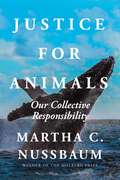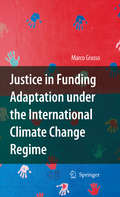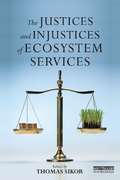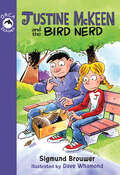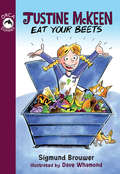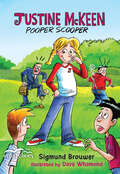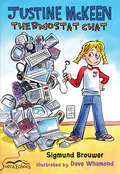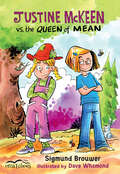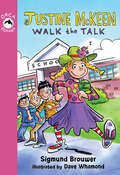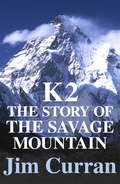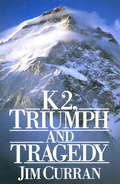- Table View
- List View
Just Me and My Dad
by Mercer MayerLittle Critter and his dad go camping. They build a campfire, go fishing, tell ghost stories, and have lots and lots of fun. Other books about Little Critter are available from Bookshare.
Just One Rain Away: The Ethnography of River-City Flood Control
by Stephanie C. KaneNot long ago it seemed flood control experts were close to mastering the unruly flows funnelling toward Hudson Bay and the Prairie city of Winnipeg. But as more intense and out-of-synch flood events occur, wary cities like Winnipeg continue to depend on systems and specifications that will soon be out of date. Rivers have impulses that defy many of the basic human assumptions underpinning otherwise sophisticated technologies. This is the river-city expression of climate change.In Just One Rain Away Stephanie Kane shows how geoscience, engineering, and law converge to affect flood control in Winnipeg. She questions technicalities produced and maintained in tandem with settler folkways at the expense of the plural legal cultures of Indigenous nations. The dynamics of this experimental ethnography feel familiar yet strange: here, many of the starring actors are not human. Ice and water – materializing as bodies, elements, and digital signals – act with diatoms, diversions, sensors, sandbags, and satellites, looping theories about glacial erratics and feminist science studies into scenes from neighbourhood parks, conferences, survey maps, plays, archival photos, a novel, an emergency press conference, LiDAR images, and a lab experiment in a bathtub. Through storytelling and environmental analytics, Just One Rain Away provides a starting point for cross-cultural discussions about how expert knowledge and practice should inform egalitarian decision-making about flood control and, more broadly, decolonize current ways of thinking, being, and becoming with rivers.
Just SNOW Already!
by Howard McWilliamNothing is as fun as snow, except maybe all the craziness happening right outside this little boy's window! Will he even notice? Nothing is as fun as snow! When the forecast calls for snow, one little boy is thrilled at the prospect of snowmen, snow angels, and sledding down snowy slopes. While wishing, waiting, and watching, the boy keeps peeking outside to see if it's snowing - but he only looks up! His single-minded focus on the sky makes him completely miss the increasingly comical chaos occurring outside his door, which includes a monster truck, a firetruck, escaped monkeys, and carousing clowns. The boy bides his time and tries to wait patiently, but waiting is boring! As the hours go by and not a snowflake is seen, the boy begins to worry that it might NEVER snow again! Will his future contain only mud-men, leaf angels, and sledding on grass? That's no fun! If only he would notice all of the wacky events unfolding outside! Finally, when the boy is just about to give up, the long-awaited white stuff arrives with a single jubilant word - SNOW! All of his frustration instantly disappears, and the boy rushes outside declaring, "I knew it would snow! I knew it!" Still oblivious to the pandemonium around him, he concludes, "Nothing's as fun as snow!" Bursting with vibrancy and hilarious details, Just SNOW Already! captures children's love of snow - as well as the frustrating side of waiting – while offering a humorous lesson about living in the moment and noticing what's around you. Kids will love poring over the hilarious outdoor scenes while keeping their eyes peeled for the first flake of snow. They can follow the costumed birthday party attendees, delivery men trying to get a large couch through a small doorway, the chain of events caused by a dog chasing a cat, a bird battle, the ups and downs of the house painter, the postal worker's mail mishap, the monkeys' and clowns' escapades, the firefighters' rescue, the games played by his sister and her friend, all of the neighbors' activities in their homes, and much much more.
Just So Stories
by Rudyard Kipling Paul Bransom J. M. GleesonFor Mowgli movie fans, the must-have companion to The Jungle Book!Children all around the world are fascinated by the animal kingdom, and that’s what makes the Just So Stories a perennial classic… Elephants, kangaroos, cats, leopards, and more. This complete volume of Rudyard Kipling’s masterpiece includes all 12 original stories: How the Whale Got His Throat How the Camel Got His Hump How the Rhinoceros Got His Skin How the Leopard Got His Spots The Elephant’s Child The Sing-Song of Old Man Kangaroo The Beginning of the Armadillos How the First Letter was Written How the Alphabet was Made The Crab that Played with the Sea The Cat that Walked by Himself The Butterfly that StampedKipling first entertained his own children with these delightful and humorous tales before deciding to write them down for publication. The parables are written in the form of what came to be known as “why” stories, each explaining how and why certain things came to be as they are.In addition to these clever fables, this volume features thirteen full-color illustrations and more than thirty black-and-white illustrations by J. M. Gleeson and Paul Bransom, as well as several images created by Kipling himself. With their entertaining characters and well-executed narrative arcs, the Just So Stories are perfect for readers both young and old—to read separately and, more importantly, together.
Just Sustainabilities: Development in an Unequal World (Urban And Industrial Environments Ser.)
by Julian Agyeman Robert D. Bullard Bob EvansEnvironmental activists and academics alike are realizing that a sustainable society must be a just one. Environmental degradation is almost always linked to questions of human equality and quality of life. Throughout the world, those segments of the population that have the least political power and are the most marginalized are selectively victimized by environmental crises. This book argues that social and environmental justice within and between nations should be an integral part of the policies and agreements that promote sustainable development. The book addresses the links between environmental quality and human equality and between sustainability and environmental justice.
The Just Transition: A Systems-Thinking Approach To Managing Climate Action
by John MorrisonManaging the climate transition will be one of the biggest challenges ever faced by business and government. While the technical and financial elements of climate transition are vast, the social challenges are even greater. If local populations and workers feel the transitions are not “just” they will resist, and that social opposition now represents one of the greatest barriers to reaching Net Zero by 2050. While the phrase ‘Just Transition’ was in the preamble to the 2015 Paris Climate Agreement, it is only now that business, finance and governments are starting to discuss what this might mean in practice. Thousands of companies are now starting to develop transition plans alongside those of governments. This book shows how all managers can best integrate social elements into these plans, consult with the people most affected by the transition out of the high carbon economy, and ensure that what looks good on paper works in practice. It takes a systems-thinking approach, focusing on the interconnections and interdependence of environmental, social and governance issues. The challenge is immense, and the changes will need to be profound. Each chapter in the book will look at the main domains in which management and policy challenges will be faced. From massively increasing the extraction of rare earth metals, most of which sit below, or adjacent to, indigenous land, to building the infrastructure needed to generate and distribute green energy, possibly over “Not in My Back Yard’ objections, the task of business and government in ensuring that these changes are fair, and perceived as fair, is immense. This book provides the roadmap for how to get there. Managing the social impacts of the climate transition will be one of the biggest challenges ever faced by business and government.
A Just Transition to Decarbonisation: Themes of Loss and Damage, Transport, Nature and Youth (Just Transitions)
by Susie Siew Ho Diane Kraal Gerry Nagtzaam Katie O’Bryan Jadranka PetrovicThis book provides researchers and policy-makers with legal avenues to enable a just transition to decarbonisation. The focus is on the United Nations themes of loss and damage, transport, nature and youth - across Australia and other economies - to significantly reduce CO2 emissions by 2030 and beyond. The four themes scaffold discussions about a just transition beyond the UN Climate Change Conference COP28 in Dubai with the specific issues addressed in this book serving as a starting point for future discussions.
Just Transitions: Gender and Power in India’s Climate Politics (Routledge Studies in Gender and Environments)
by Seema Arora-Jonsson Kavya Michael Manish Kumar ShrivastavaThis book turns critical feminist scrutiny on national climate policies in India and examines what transition might really mean for marginalized groups in the country. A vision of “just transitions” is increasingly being used by activists and groups to ensure that pathways towards sustainable futures are equitable and inclusive. Exploring this concept, this volume provides a feminist study of what it would take to ensure just transitions in India where gender, in relation to its interesting dimensions of power, is at the centre of analysis. With case studies on climate mitigation and adaptation from different parts of India, the book brings together academics, practitioners and policymakers who provide commentary on sectors including agriculture, forestry and renewables. Overall, the book has relevance far beyond India’s borders, as India’s attempt to deal with its diverse population makes it a key litmus test for countries seeking to transition against a backdrop of inequality both in the Global North and South. This volume will be of great interest to students and scholars of climate policy, gender studies, sustainable development and development studies more broadly.
Just Transitions: Promise and Contestation (Elements in Earth System Governance)
by Dimitris StevisJust transition prompts us to explore a number of important dimensions of Earth System Governance research, including sustainability transformations, inequality, power and justice. This Element aims to place just transition in the dynamics of the world political economy over the last several decades and to offer an overview of the varieties of just transitions based on an analytical scheme that focuses on their breadth (coverage), depth (social and ecological priorities) and ambition. The focus on breadth, depth and ambition centers on power, inequality and injustice and allows us to analyze and compare just transitions as a prerequisite for their fuller interpretation.
Just Transitions and the Future of Law and Regulation (Palgrave Studies in Environmental Transformation, Transition and Accountability)
by Alexandra R. HarringtonThis book provides a comprehensive assessment of how national and international efforts to achieve carbon neutrality have been embraced as necessary to meet the requirements of the Paris Agreement as well as the needs of the planet. The authors explore the increasing tensions between aspirations and entrenched practices as methods to implement carbon neutrality are devised, particularly at the national and sub-national levels. This is perhaps best typified by efforts to shift from “dirty” energy production, such as coal, to greener alternatives, which are often supported in laws and rules but opposed by society. To bridge this void, the concept of just transitions has increasingly come to the forefront of international and national focus yet is often poorly understood. This book examines the ways in which just transitions have been proposed as a legal and regulatory bridge to address issues that result in societal resistance to implementation. It uses past and existing practice studies of just transitions before providing an analysis of how just transitions can be used to not only to assist in the shift to carbon neutrality but also in new shifts such as those caused by the Covid-19 pandemic impacts on economy, environment and society, and to address future global challenges.
Just Under the Clouds (Chicka Chicka Book)
by Melissa SarnoCan you still have a home if you don't have a house? In the spirit of The Truth About Jellyfish and Fish in a Tree comes a stunning debut about a family struggling to find something lasting when everything feels so fleeting.Always think in threes and you'll never fall, Cora's father told her when she was a little girl. Two feet, one hand. Two hands, one foot. That was all Cora needed to know to climb the trees of Brooklyn.But now Cora is a middle schooler, a big sister, and homeless. Her mother is trying to hold the family together after her father's death, and Cora must look after her sister, Adare, who's just different, their mother insists. Quick to smile, Adare hates wearing shoes, rarely speaks, and appears untroubled by the question Cora can't help but ask: How will she find a place to call home? After their room at the shelter is ransacked, Cora's mother looks to an old friend for help, and Cora finally finds what she has been looking for: Ailanthus altissima, the "tree of heaven," which can grow in even the worst conditions. It sets her on a path to discover a deeper truth about where she really belongs. Just Under the Clouds will take root in your heart and blossom long after you've turned the last page.
Justice and Natural Resources: Concepts, Strategies, and Applications
by Douglas Kenney Gerald Torres Kathryn Mutz Gary BrynerJust over two decades ago, research findings that environmentally hazardous facilities were more likely to be sited near poor and minority communities gave rise to the environmental justice movement. Yet inequitable distribution of the burdens of industrial facilities and pollution is only half of the problem; poor and minority communities are often denied the benefits of natural resources and can suffer disproportionate harm from decisions about their management and use. Justice and Natural Resources is the first book devoted to exploring the concept of environmental justice in the realm of natural resources. Contributors consider how decisions about the management and use of natural resources can exacerbate social injustice and the problems of disadvantaged communities. Looking at issues that are predominantly rural and western -- many of them involving Indian reservations, public lands, and resource development activities -- it offers a new and more expansive view of environmental justice. Justice and Natural Resources offers a concise overview of the field of environmental justice and a set of frameworks for understanding it. It expands the previously urban and industrial scope of the movement to include distribution of the burdens and access to the benefits of natural resources, broadening environmental justice to a truly nationwide concern.
Justice for Animals: Our Collective Responsibility
by Martha C. NussbaumA revolutionary new theory and call to action on animal rights, ethics, and law from the renowned philosopher Martha C. Nussbaum.Animals are in trouble all over the world. Whether through the cruelties of the factory meat industry, poaching and game hunting, habitat destruction, or neglect of the companion animals that people purport to love, animals suffer injustice and horrors at our hands every day. The world needs an ethical awakening, a consciousness-raising movement of international proportions. In Justice for Animals, one of the world&’s most influential philosophers and humanists Martha C. Nussbaum provides a revolutionary approach to animal rights, ethics, and law. From dolphins to crows, elephants to octopuses, Nussbaum examines the entire animal kingdom, showcasing the lives of animals with wonder, awe, and compassion to understand how we can create a world in which human beings are truly friends of animals, not exploiters or users. All animals should have a shot at flourishing in their own way. Humans have a collective duty to face and solve animal harm. An urgent call to action and a manual for change, Nussbaum&’s groundbreaking theory directs politics and law to help us meet our ethical responsibilities as no book has done before.
Justice in Funding Adaptation under the International Climate Change Regime
by Marco GrassoCovering the ethical dimensions of international-level adaptation funding, a subject of growing interest in the climate change debate, this book provides a theoretical analysis of the ethical foundations of the UNFCCC regime on adaptation funding, one that culminates in the definition of a framework of justice. The text features an interpretative analysis of the ethical contents of the UNFCCC funding architecture by applying the framework of justice proposed to different areas of empirical investigation. The book offers scholars working on climate change, international relations, and environmental politics an analysis characterized by both theoretical soundness and empirical richness. The comprehensiveness of the book's approach should make it possible to plan and implement international adaptation funding more effectively, and eventually to define more just funding policies and practices.
The Justices and Injustices of Ecosystem Services (Routledge Studies in Ecosystem Services)
by Thomas SikorHumankind benefits from a multitude of resources and processes that are supplied by ecosystems, and collectively these benefits are known as ecosystem services. Interest in this topic has grown exponentially over the last decade, as biologists and economists have tried to quantify these benefits to justify management interventions. Yet, as this book demonstrates, the implications for justice and injustice have rarely been explored and works on environmental justice are only now addressing the importance of ecosystem services. The authors establish important new middle ground in arguments between conservationists and critics of market-based interventions such as Payment for Ecosystem Services. Neither can environmental management be separated from justice concerns, as some conservationists like to believe, nor is it in fundamental opposition to justice, as critics like to put it. The book develops this novel interpretation of justice in environmental management through analyses of prominent governance interventions and the conceptual underpinnings of the ecosystem services framework. Key examples described are revenue-sharing around protected areas and REDD+ for forest ecosystems. The analyses demonstrate that interventions create opportunities for enhancing social justice, yet also reveal critical design features that cause ostensibly technical interventions to generate injustices.
Justine McKeen and the Bird Nerd (Orca Echoes)
by Sigmund BrouwerMeet Justine McKeen, the Queen of Green. She's trying to save the planet, one person at a time, and when she decides to get something done, it's a lot of fun. When a small bird is injured after flying into a school window, the students are shocked and upset. But they are even more shocked when school bully Jimmy Blatzo rescues the bird and nurses it back to health. Blatzo may have saved one bird, but the problem is much bigger and not confined to the school grounds. Birds are flying into the windows at the town hall too. With the help of Justine, green activist extraordinaire, Blatzo gets the courage he needs to approach town council. Getting over his fear of public speaking will be one challenge. Getting used to his new nickname, Bird Nerd, will be another matter entirely. The epub edition of this title is fully accessible.
Justine McKeen, Bottle Throttle (Orca Echoes)
by Sigmund BrouwerIn this early chapter book, the seventh installment in the Justine McKeen series, Justine sets out to ban bottled water from her school.
Justine McKeen, Eat Your Beets (Orca Echoes)
by Sigmund Brouwer Dave WhamondMeet Justine McKeen, the Queen of Green. She talks a little too much, bosses a little too much and tells the truth, just not all at once. She's trying to save the planet, one person at a time, and when she decides to get something done, it's a lot of fun. In Justine McKeen, Eat Your Beets, the fourth book in the Justine McKeen series, Justine has another brilliant idea to help the planet. When she learns a stray cat and her kittens are living off the food in their school Dumpster, Justine sets out to reduce waste and help save animals in need. Her friends are supportive, but convincing grumpy Mr. Raymond, the cafeteria's manager, to help them put Justine's plan in action is another matter altogether.
Justine McKeen, Pooper Scooper (Orca Echoes)
by Sigmund BrouwerJustine McKeen, the Queen of Green is ready for her third adventure! Justine McKeen talks a little too much, bosses a little too much, and tells the truth, just not all at once. She's trying to save the planet, one person at a time, and when she decides to get something done, it's a lot of fun. In Justine McKeen, Pooper Scooper, the third book in the Justine McKeen series, Justine gets her friends to help her clean up the dog poop in the park across from the school board's offices in an effort to get the attention of the superintendent of schools. She hopes the efforts of her crew of cheerful pooper scoopers will help get the superintendent to see that bringing their school librarian back to work is the right thing to do.
Justine McKeen, Queen of Green (Orca Echoes)
by Sigmund BrouwerJustine's trying to save the planet, one person and one cause at a time. Justine McKeen talks too much, bosses people around too much, and as everyone soon finds out, she tells the truth, but just not all at once. Best of all, when she decides to get something done, it involves a whole lot of laughter and fun for everyone.
Justine McKeen, Thermostat Chat (Orca Echoes)
by Sigmund Brouwer Dave WhamondJustine McKeen is on another mission, this time to rid homes and schools of energy vampires. Justine and her friends, with the help of Principal Proctor, are working to reduce the energy consumption of electronics that suck power from the school when they aren't being used. By cutting down on the miscellaneous electrical load of these electronics, the team is also saving money, reducing greenhouse gas emissions and fighting global warming. Too bad they didn't warn Grandpa Blatzo before they started slaying the vampires! Justine McKeen, Thermostat Chat is part of the Justine McKeen series featuring the Queen of Green.
Justine Mckeen vs. the Queen of Mean (Orca Echoes)
by Sigmund BrouwerJustine McKeen is back, and she’s on a deadline. With only days left before Earth Day, Justine enlists the help of her classmates to count flower buds, frogs, spiders and ants in their natural habitat as part of an environmental science project. But there’s a species right in her own classroom that she’ll have to tackle first--a class bully. Savannah Blue, aka the Queen of Mean, criticizes Justine’s secondhand clothes and calls being green a waste of time. Their teacher, Mrs. Howie, gives the girls a new assignment for Earth Day--they must present together to the class on why it’s important to care for the environment. In the sixth book in this bestselling series, Justine is up against her biggest challenge yet--can she convince the Queen of Mean to go green? The epub edition of this title is fully accessible.
Justine McKeen, Walk the Talk (Orca Echoes)
by Sigmund BrouwerMeet Justine McKeen. She's the Queen of Green! She talks a little too much, bosses a little too much and tells the truth, just not all at once. She's trying to save the planet, one person at a time, and when she decides to get something done, it's a lot of fun. In Justine McKeen, Walk the Talk, the second book in the Justine McKeen series, Justine decides there are too many cars idling in front of her school. So she comes up with a solution that should help keep the air cleaner. But she soon discovers not many adults trust her crazy ideas.
K2: The Story Of The Savage Mountain
by Jim CurranK2 is the world's second highest mountain, but its savage reputation is second to none. The loss of Alison Hargreaves and six companions in 1995 was a grim echo of the multiple deaths in 1986 and of earlier disasters which have become part of climbing legend. K2 has always attracted the greatest names in mountaineering. Wiessner, Houston, Bonatti, Diemberger and Bonington are among those whose lives have been permanently scarred by their experiences on it. At the same time some inspiring new routes have been achieved on the world's most difficult 8000-metre peak. Jim Curran, himself a survivor of 1986, has traced the history of the mountain from the nineteenth-century pioneer explorers down to the present, and sees a repeating pattern of naked ambition, rivalry, misjudgement and recrimination. He has also found selfless heroism and impressive route-making on the mountain that top climbers will always covet as the ultimate prize.
K2: Triumph And Tragedy
by Jim CurranK2 is the second highest mountain in the world, at 8611 metres only a couple of hundred metres lower than Everest. It is one of the most unrelenting and testing of the worlds 8000-metre peaks. Jim Curran came to K2 as a climbing cameraman with an unsuccessful British expedition, but stayed on through the climbing season. This is his account of the dramatic events of that summer, a story of ambitions both achieved and thwarted on a mountain which all high-altitude climbers take the most pride in overcoming. In 1986 K2 took its toll of those ambitions. Curran vividly describes the moments that contribute to the exhilaration of climbing on the world's most demanding mountain, and he assesses the tragedy of that summer with compassion and impartiality.
